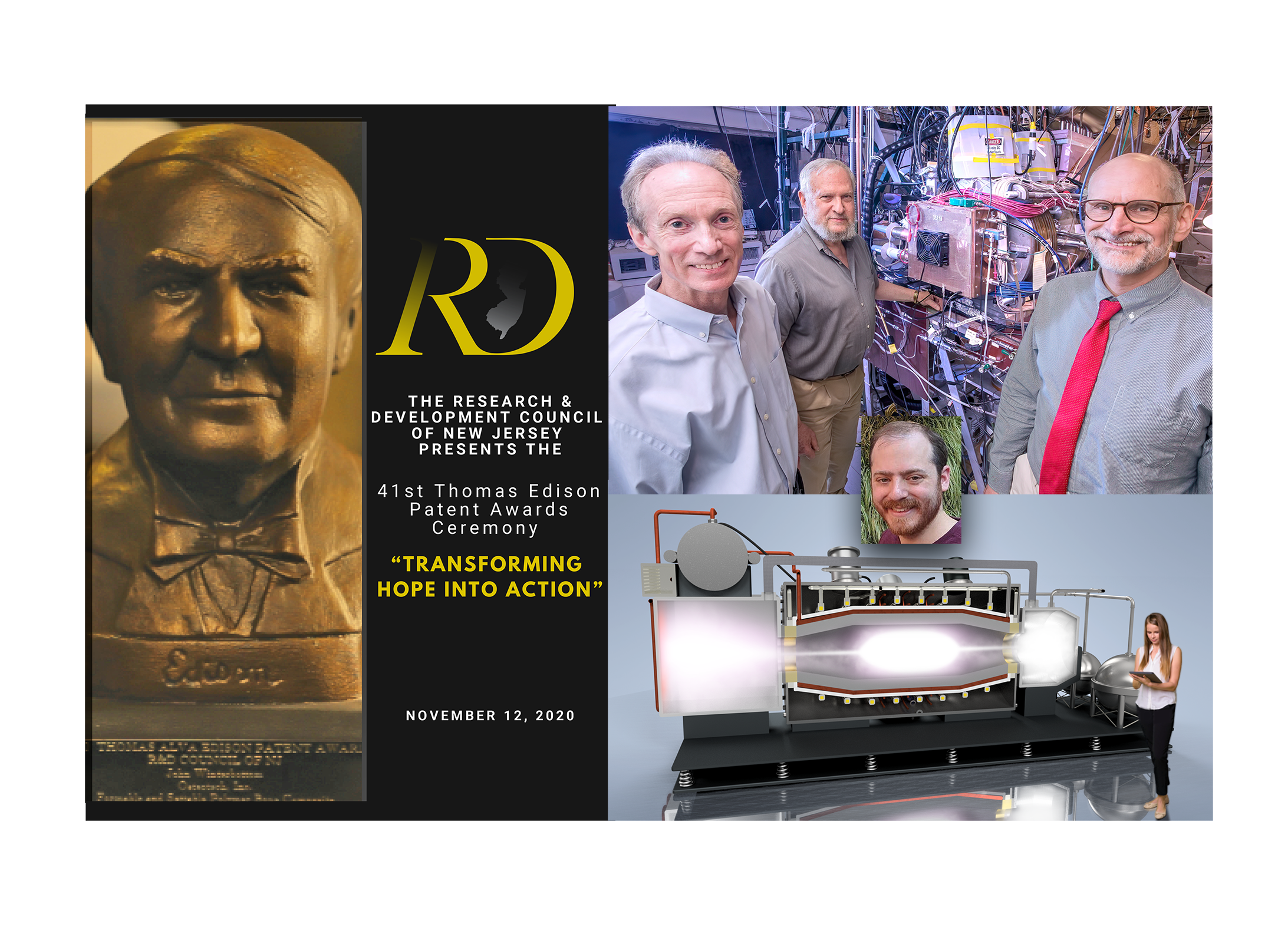Cohen, along with Michael Paluszek, president of Princeton Satellite Systems (PSS); Gary Pajer, formerly of Princeton Satellite Systems; and Yosef S. Razin, a former graduate student of Cohen’s who later worked for the company, will receive the award during a virtual ceremony on Nov. 12 that will honor inventors of 14 patents in New Jersey.
“Thomas Edison has made contributions to so many fields, whether it’s entertainment, industry or national security, from the phonograph to national laboratories,” Cohen said. “We’re greatly honored to have our efforts associated with his name. We hope to make contributions in research and furthering science and providing electrical power in space exploration and to people who most need it.”
“Congratulations to Sam and his partners for this recognition,” said Steve Cowley, director of PPPL. “We are proud of Sam and other scientists like him at PPPL whose research is creating the technologies of tomorrow. “
Third Edison Award for PPPL
This is the third time PPPL researchers have received Edison awards over the past few years. A team of researchers received the award in 2017 for an imaging apparatus that could be used to create the next generation of integrated circuits. Researchers received the award the previous year for a method to create an isotope used routinely in medical imaging devices to diagnose such conditions as heart disease and cancer.
Cohen is a Princeton University lecturer with the rank of professor in astrophysical sciences who has been a researcher at PPPL for almost five decades. He joined PPPL in 1973 after receiving undergraduate and graduate degrees in physics from MIT. Cohen worked on several physics experiments at PPPL during the first two decades of his career, including the Symmetric Tokamak, the Adiabatic Toroidal Compressor, the Princeton Large Torus, and the Poloidal Divertor Experiment. He also worked on the Joint European Torus in the United Kingdom and was head of the ITER Power and Particle Control Group from 1991 to 1993. He is a fellow of the American Physical Society.
Cohen co-directs with James Sturm, a Princeton University electrical engineering professor, the Program in Plasma Science and Technology (PPST) at PPPL through the University’s School of Engineering and Applied Science. Some 100 undergraduates have done hands-on research in plasma science through the program. Among them was Yosef Razin, one of his collaborators on the fusion propulsion concept, who was an intern with Cohen and went on to work for Princeton Satellite Systems before going to the Georgia Institute of Technology’s College of Engineering for his Ph.D. in robotics.
Cohen and his partners received a U.S. patent for their “method and apparatus to produce high specific impulse and moderate thrust from a fusion powered rocket engine” in 2017. The rocket propulsion concept is based on Cohen’s Princeton Field Reversed Configuration (PFRC-2) experiment at PPPL. The reactor has a cylindrical chamber surrounded by superconducting coils or magnets with powerful magnets at each end. The idea is to produce a dense ionized plasma that would hold itself together and produce a fusion reaction that would propel the rocket. Such a propulsion system could be used for deep space exploration.
The rocket technology would use deuterium, an isotope of hydrogen, and helium-2 as a fuel. The concept is for a device based on the PFRC-2 that would be about the size of a minivan. The ions are heated by radio frequency waves, which act similarly to microwaves to heat the plasma. A rocket propelled by such an engine would be lightweight compared to traditional chemically-fueled rockets and would use much less energy.
One of four patents for Cohen
Cohen recently received a patent, with Matthew Chu-Cheong, a PPST intern at PPPL in 2012 who is now a graduate student at the University of Texas at Austin, for a “system and method for small, clean steady state fusion reactor” based on the PFRC technology. It is the fourth Cohen has receivedfor related technologies, including a Japanese patent for the rocket technology. Cohen and Princeton Satellite Systems won a Federal Laboratory Consortium Award from the Northeast Federal Laboratory Consortium for the rocket propulsion technology in 2019. PSS is an active research partner with PPPL and a licensee of Princeton/PPPL patents related to this thruster technology. Several more patent applications are pending.
“It’s an honor to see the Lab and it’s licensee, Princeton Satellite Systems, recognized by the NJ R&D Council for this thruster technology, which could have a great impact in space exploration in the future,” said Laurie Bagley, head of Technology Transfer.
Cohen received about $700,000 of a $1.25 million award from the federal Advanced Research Projects Agency-Energy (ARPA-E) in 2019 for research on the PFRC-2 with the goal of upgrades to the PFRC-2 to improve ion heating. The ultimate goal of the ARPA-E subcontract is to produce devices for “high value applications,” such as electricity generation during natural disasters. Princeton Satellite Systems in partnership with Cohen also received a $750,000 contract in 2018 from NASA’s Small Business Technology Transfer Research Phase II program for research on superconducting magnets on Cohen’s PFRC-2 with applications for advanced propulsion systems for space travel.
Cohen said he is constantly finding new areas to explore in his research. “I like doing physics,” Cohen said. “It’s kind of like watching your grandchildren, whatever they’re doing is exciting and new. That’s what I like about physics: it’s always exciting and new.”
PPPL, on Princeton University’s Forrestal Campus in Plainsboro, N.J., is devoted to creating new knowledge about the physics of plasmas — ultra-hot, charged gases — and to developing practical solutions for the creation of fusion energy. The Laboratory is managed by the University for the U.S. Department of Energy’s Office of Science, which is the largest single supporter of basic research in the physical sciences in the United States, and is working to address some of the most pressing challenges of our time. For more information, please visit science.energy.gov.




